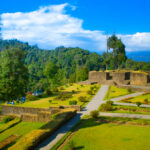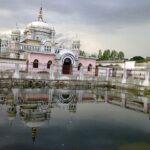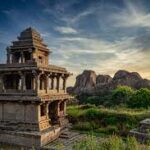Now Reading: Top 5 Best Places Visiting in Palwal for Heritage, Spirituality & Nature
-
01
Top 5 Best Places Visiting in Palwal for Heritage, Spirituality & Nature

Top 5 Best Places Visiting in Palwal for Heritage, Spirituality & Nature
1.Sati Temple

The Sati Temple together with its adjoining pond exists in Hodal making it a sacred place that shows the spiritual heritage of this area. People from all over visit this holy place which worships Devi Sati because they come every year and especially because of the Mela annual festival that takes place during January.
The combination of calm nature surroundings with spiritual energy along with animated cultural traditions makes the Sati Temple and Pond into an attraction that draws both worshipers and visitors together.
Significance
The Sati Temple maintains strong religious significance for local residents since it honors Devi Sati who stands as a main goddess of Hindu belief. During the January fair female devotees alongside others visit the temple to pray while seeking blessings from the goddess. The religious rituals lead devotees to perform their ceremonies with devotion leading to a sacred ambiance through the release of spiritual energy.
The Sati Pond stands near the temple creating a serene settings alongside the temple that generates peaceful energy over the entire site. Believed sacred by believers the pond creates additional charm for the temple as a space for peaceful meditation and contemplation.
Best Time to Visit
One should plan to visit the Sati Temple during the January Mela to experience its full religious and cultural festivities that animate both the temple complex and its surroundings.
The temple can provide peaceful worship conditions to visitors who choose to visit throughout the year besides major celebrations.
2.ANJANI KUND

Anjani Kund along with its adjacent Hanuman Temple remain crucial sacred locations because they lie within the spiritual Braj territory. The mystical forests of Braj hold these holy sites which remain strongly linked to the Maha Raas celebrations of Lord Krishna and the historic tales of Hanuman.
People visit this sacred location primarily during Tuesday and Saturday because crowds of pilgrims come to receive favorable blessings from Lord Hanuman. Anjani Kund maintains an important status as a pilgrimage attraction because it participates in the Braj Chaurasi Kos Yatra’s popular route.
Legend tells that during the Maha Raas Krishna vanished from the Raas dance so the Braj milkmaids combed through every part of the forest as they sought him. The search for Krishna led them exactly to this location.
People associate this site with an enchanting story showing Mother Yashoda searching for Krishna. Yashoda and her servants visited the forest to search for Krishna because he failed to return home on time. After sensing his mother’s anxiety and fearing her upcoming anger Krishna quickly changed into Lord Hanuman thus coming out from Anjani Kund which is now a local pond.
Hanuman appeared before Yashoda who then eliminated her worrying behavior because she decided to worship Hanuman fervently prior to heading back to her home. Anjani Kund obtained its name from that miraculous occasion because Hanuman who belongs to Anjani Mata emerged from that pond.
Best Time to Visit
Devotees should choose to visit Hanuman Temple and Anjani Kund on Tuesdays and Saturdays because these days offer the most powerful schedule of religious devotions. Visitors who attend festivities including Hanuman Jayanti alongside Braj Chaurasi Kos Yatra receive an enriched experience because they get to experience exciting rituals and exuberant celebrations.
3.Monuments of National

Numerous ancient buildings including archaeological wonders and religious sanctuaries exist across Haryana because they exhibit the multiple cultural elements which have shaped the region. There are 90 National Heritage Monuments which the Archaeological Survey of India (ASI) has recognized in Haryana. The ASI regulates these historical landmarks because they bring together three vital aspects from historical, architectural, and cultural perspectives.
The ASI assigns specific identifiers to each monument that combines the state code and ASI circle number with sequential numbers according to their official enumeration system.
Highlights of the Monuments in Haryana
- Ancient Sites and Excavations
- Brahma Sarovar located in Kurukshetra represents a holy water reservoir which has connections to the events detailed in the Mahabharata.
- The Panipat Battlefield Monuments consist of ancient historical remains from where three historic Panipat battles occurred in Panipat.
- Medieval Monuments
- This Mughal masterpiece named Sheikh Chilli’s Tomb stands in Thanesar and serves as a memorial to Sufi saint Sheikh Chilli.
- The Mughal emperors constructed Kos Minars as distance markers along the Grand Trunk Road.
- Religious Structures
- At Surajkund in Faridabad exists a sacred water reservoir and temple complex linked to Surya (the Sun God).
- People from various religious backgrounds visit the Sufi shrine of Dargah of Bu Ali Shah Qalandar located in Panipat.
- Archaeological Ruins and Stupas
- The site of Buddhist Stupa at Sugh in Yamunanagar maintains ancient stupas that span from the Mauryan to the Kushana phase.
- Ruins of Old Fort in Hansi serves as a critical historic monument that reveals Haryana’s medieval times.
- Sculptural and Architectural Marvels
- Feroz Shah Tughlaq ruled during this time when his palace and fort were constructed in Hisar following Indo-Islamic architectural design.
Best Time to Visit:
Travelers should visit the historical monuments of Haryana between October and March to enjoy the best visiting experience.
4.Gandhi Museum

A historically important museum named Gandhi Seva Ashram stands in the city of Palwal which belongs to Haryana. The Palwal Railway Station provides a convenient location for the museum that honors Mahatma Gandhi through its mission to protect Indian freedom movement history specifically related to Gandhiji.
The museum maintains personal significance to an essential moment when India fought for independence. On April 10, 1919 the British authorities arrested Mahatma Gandhi during his travel from Palwal Railway Station toward Punjab to protest against the Rowlatt Act which limited civil rights and opposed public expression. Gandhi’s detainment pushed India toward a definitive shift toward peaceful opposition against British administration.
Netaji Subhash Chandra Bose started the Gandhi Seva Ashram as a memorial on October 2, 1938 to mark the birth anniversary of Mahatma Gandhi.
Highlights
The Gandhi Seva Ashram Museum features a collection of historic items which the visitors can see.
A collection of both historic photographs together with important documents chronicles key events from Gandhiji’s life during the Salt March as well as during the Quit India Movement in addition to his time in South Africa.
Exhibits on the Freedom Struggle: Showcasing the timeline of India’s path to independence and Gandhiji’s contributions to non-violent resistance.
Exhibit displays both personal possessions and everyday objects from Gandhiji’s life to showcase his doctrine of simplicity and autonomy.
The longevity and significance for future times have been secured through restorations of numerous historical exhibits.
- October through March represents the optimal period to visit because summer temperatures create an unfavorable visiting experience.
5.Maharani Kishori Shahi Mahal

A remarkable historic construction called the Maharani Kishori Shahi Mahal stands proudly in Hodal part of district Palwal within Haryana state. The structure showcases royal excellence from its era because it honors Maharani Kishori who belonged to the royal Bharatpur family.
Historic ruler Maharaja Suraj Mal married Maharani Kishori who became the famous wife of the legendary Bharatpur ruler because of her ability to lead as well as her courageous nature and administrative talents. Through her leadership positions Maharani Kishori gained widespread respect because of her diplomatic abilities and intellectual acumen in addition to her benevolent nature in the region’s political development.
Construction of The Mahal took place during the rule of Maharaja Suraj Mal and it served as his expression of love and admiration for his wife Maharani Kishori. This establishment functioned as a peaceful royal sanctuary which simultaneously showcased the majestic might of the Bharatpur royal family.
Related articles : Top 4 Best Places Visiting in Nuh for Heritage, Spirituality & Nature
Stay Informed With the Latest & Most Important News
Previous Post
Next Post
-
 01Top 5 Best Places Visiting in Gyalshing – Monasteries, Lakes & Scenic Escapes
01Top 5 Best Places Visiting in Gyalshing – Monasteries, Lakes & Scenic Escapes -
 02Top 5 Best Places Visiting in Panna – Temples, Waterfalls & Wildlife Escapes
02Top 5 Best Places Visiting in Panna – Temples, Waterfalls & Wildlife Escapes -
 03Top 5 Best Places to Visit in Malerkotla – Malerkotla Fort, Sheesh Mahal & More
03Top 5 Best Places to Visit in Malerkotla – Malerkotla Fort, Sheesh Mahal & More -
 04Top 10 Best Places Visiting in Dakshina Kannad for Culture, Nature & Coastal Charm
04Top 10 Best Places Visiting in Dakshina Kannad for Culture, Nature & Coastal Charm -
 05Top 2 Best Places Visiting in Chitradurga for History, Nature & Adventure
05Top 2 Best Places Visiting in Chitradurga for History, Nature & Adventure -
 06Best Places Visiting in Shopian – Explore Top Attractions & Hidden Gems
06Best Places Visiting in Shopian – Explore Top Attractions & Hidden Gems -
 07Best Places Visiting in Narmadapuram – Temples, Waterfalls & Wildlife Escapes
07Best Places Visiting in Narmadapuram – Temples, Waterfalls & Wildlife Escapes














Pingback: Top 5 Best Places Visiting in Panchkula – Explore Haryana's Scenic Gem